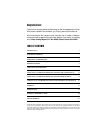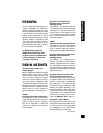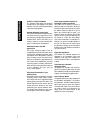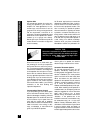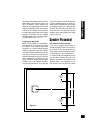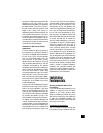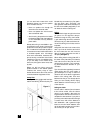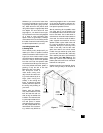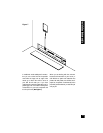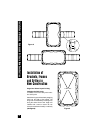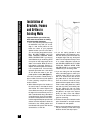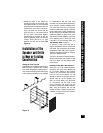
you can avoid wire routes which could
potentially induce hum over the speaker
wire. The basic rules are:
• Never run speaker wire through the
same hole as an electrical cable.
• Never run speaker wire into the same
J-box as electrical cable.
• Avoid running the speaker wire beside
the electrical cable. Keep it at least three
or four feet distant from any electrical
power cable.
Side-by-side wiring is unavoidable in par-
ticular spots in every house, just move the
speaker wire route away as soon as possi-
ble. If construction forces a side by side run
for more than ten feet, install metal conduit
or shielded speaker wire. Low-voltage
wires such as doorbells, intercoms, tele-
phone, security, or television cannot cause
interference or hum on your speaker wires,
so you can safely run all of them at the
same time, through the same holes, side-
by-side.
Before you drill any holes, mount the
speaker brackets in the desired speaker
locations and mount p-rings or open
backed J-boxes where the in-wall volume
controls and stereo equipment will be.
Safety First!
Wear gloves, safety goggles and head pro-
tection when drilling. Avoid nails, they ruin
bits and they can create injury. Pay partic-
ular care when using “hole-hogs” and
other powerful electric drills; the torque of
the drill when suddenly stopped by a nail
can break the wrist of a strong man.
Drilling
Use a bit that is large enough for the wires
you plan to run. An auger bit is the pre-
ferred bit for rough-in wiring. It will actual-
ly pull itself through the wood, so that the
drill motor, not you, does most of the work.
You will be drilling a lot of holes, so this is
important.
Always drill the holes in the center of the
stud. If you have to notch the stud or drill
the hole closer than one inch from the
edge of the stud, protect the wire with a
nail plate (See Figure 3).
When drilling holes in ceiling joists, drill in
the center of the joists and try to locate the
hole near the end of the joist. DO NOT
drill through a “gluelam” or any load bear-
ing beam without the direction of your
contractor.
Try to line the holes up perfectly, because it
makes pulling the wire much easier. A
good technique is to snap a chalk line
across the face of the studs or against the
bottom of the ceiling joists. Then work
backward so that you can always see the
holes you have already drilled. Paying
careful attention to this will save you a lot
of time later on!
Pulling the Cable
Pull the cable in sections (from the stereo
to the volume control, from the volume
control to the speaker). Start with the
longest sections and use left over wire to
complete the short sections. If you plan to
pull many rooms at the same time through
a central route, walk off the distance to
each destination, add a generous fudge
factor for turns and other obstacles, then
cut off each section so that you have a bun-
dle of wires you can pull at once.
Installation Fundamentals
8
Figure 3



